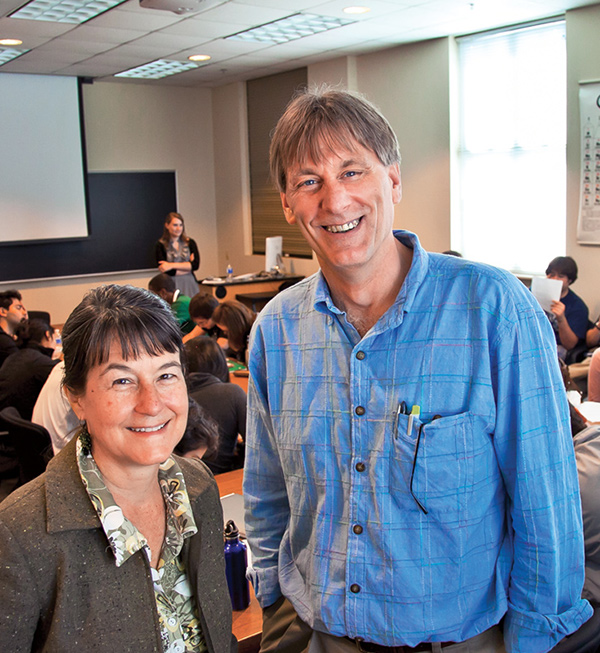Trickle-Down Knowledge
Research? Who, me? Grad students help undergrads get it

Kay Hinton
A psychologist, a neurologist, an immunologist, and an Egyptologist walk into a classroom . . .

Bridge builders: Leaders David Lynn and Leslie Taylor help connect students across ages and interests.
Kay Hinton
No, this isn’t the start of a joke. It’s an undergraduate course with the tantalizing title Blood, Brains, Death, and Disease, led by four graduate students with research interests in different academic fields. Part of a series of seminars called On Recent Discoveries by Emory Researchers, or ORDER, the course bridges the gap between undergraduates and graduate students and also between the arts and the sciences. Graduate student instructors collaborate across their disciplines to provide specific insight into how to conduct a project, walking the younger students step-by-step through their own research efforts.
The ORDER courses were conceived by David Lynn, Asa Griggs Candler Professor of Chemistry and Biology, who in 2002 was selected as one of twenty inaugural Howard Hughes Medical Institute professors to receive $1 million to bring scientific research to the undergraduate classroom. Graduate students apply to teach the courses through a competitive process, and are overseen and guided by Lynn and other faculty throughout the courses. Seminars are offered for freshmen and seniors.
“Graduate students represent the next level after undergraduate training in the career path of a scientist,” Lynn says. “Seeing that graduate students—who were themselves taking undergraduate classes only a few years earlier—are contributing to our scientific knowledge base is both very motivational to the undergraduate students and empowering for the teacher-scholars.”
This year, Lynn is partnering with Leslie Taylor, chair of the Department of Theater Studies, to lead the seminars. “David has been really interested in having scientists figure out ways to tell their stories,” Taylor says. “I’m here to talk about creativity—the idea of embedding creativity into teaching and thinking creatively about doing research. It’s not just A-B-C-D, but a series of leaps and hunches. And you need to be able to engage your audience with narrative.”
As the course unfolds, undergraduates in the class see firsthand how research is conducted and use this experience to lead a project of their own. They also learn about the career goals, life stories, and the research obstacles that the graduate students face.
“I was pleasantly surprised by the interest these students expressed in what I spend most of my time doing. The highlight of my year so far was when groups of my students created goofy songs that synthesized all of the information presented to them in a creativity workshop,” says Flora Anthony, a graduate student in Egyptology and one of the scholar-teachers. “In class, chemistry undergraduate students really helped push the boundaries of an art history inquiry.”
Anthony’s project is focused on evaluating a set of Egyptian artifacts to determine their authenticity, using both historical research and chemical testing processes supported by staff at the Michael C. Carlos Museum. The students were given a guided tour by Anthony and a walk-through of how artifacts are restored in the museum’s conservation lab.
They also got the opportunity to perform an experiment in a neuroscience wet-laboratory, guided by Jacob Shreckengost, a neuroscience graduate student. “I was amazed by the freshmen, who, after an introduction to a very complex area of spinal cord research, were able to independently devise some of the very experiments I had proposed and performed upon entering graduate school,” Shreckengost says.
Next, students visited capuchin monkeys at the Yerkes National Primate Research Center, home to groundbreaking studies on the origins of fairness. Psychology graduate student Erin Robbins gave them the chance to participate in her human versions of these experiments to see how their concepts of fairness compare to those of children and adults in cultures like Samoa and Vanuatu.
The course ended with an up-close look at blood transfusions led by Justine Liepkalns, a scholar-teacher who is studying immunology. The class saw how blood is stored and used at the Emory Blood Bank and spoke to the director of the Center for Transfusion and Cellular Therapy and to the nurse in charge of patients treated for various blood ailments.
“Research has sudden twists and turns, just like our life stories,” Robbins says. “Post-college, I thought my interests and career choices were too diverse, but through research I came to see that there was a common theme. It’s rewarding to help students find their own themes and recognize that great scholarship comes from examining alternative perspectives.”
The research topics the undergraduates pursue for their own projects reflect the interdisciplinary nature of the class, ranging currently from obesity trends to Sanskrit to cell chemistry. But they are nearly always personally meaningful to the students, which is, says Lynn, what drives discovery.






